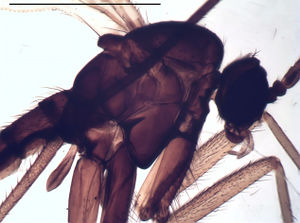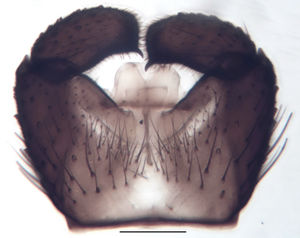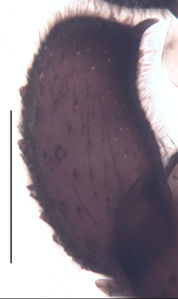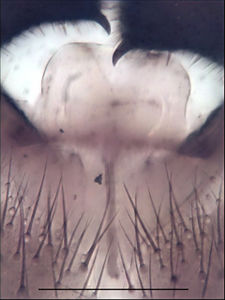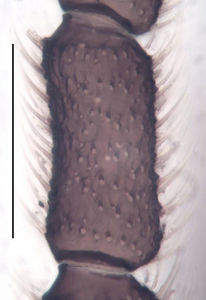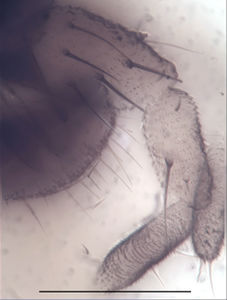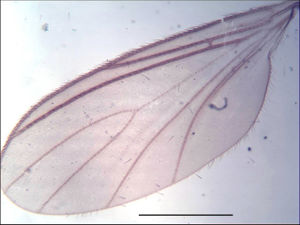Trichosiopsis orientis
Ordo: Diptera
Familia: Sciaridae
Genus: Trichosiopsis
Name
Trichosiopsis orientis unpublished
Type material
Holotype: ♂, 14.7.–10.7.2016, Malaise trap, leg. Kjærandsen & Dahl, TSZD-JKJ-103748 in TSZD
Type locality
Norway, Troms, Storfjord, Skibotn
Barcoded material
| Stadium | Country | Province | Locality | Habitat | Method | Date | Collector | Collection Number | Collection | Latitude | Longitude | Elevation (m) |
|---|---|---|---|---|---|---|---|---|---|---|---|---|
| 1 ♂ (holotype) | Norway | Troms | Storfjord, Skibotn, Langbakken 0.3 km SE Gustavsberget | Malaise trap | 14.7.–10.7.2016 | Jostein Kjærandsen & M. T. Dahl | TSZD-JKJ-103748 | TSZD | 69.2858 | 20.4508 | ||
| 1 ♂ | Norway | Finnmark | Batsfjord, Komagdalen, Bajit Suovka | Malaise trap | 14.7.–2.8.2009 | T. E. Barstad | TSZD-JKJ-103794 | TSZD | 70 | 30 | ||
| 1 ♂ | Norway | Troms | Tromso, Skjelhollet, Kvaloy | Malaise trap | 14.7.–26.7.2015 | Jostein Kjærandsen | TSZD-JKJ-103846 | TSZD | 69.768 | 18.851 | ||
| 1 ♂ | Norway | Troms | Tromso, Skjelhollet, Kvaloy | Malaise trap | 14.7.–26.7.2015 | Jostein Kjærandsen | TSZD-JKJ-103847 | TSZD | 69.768 | 18.851 | ||
| 1 ♂ | Norway | Troms | Tromso, Skjelhollet, Kvaloy | Malaise trap | 14.7.–26.7.2015 | Jostein Kjærandsen | TSZD-JKJ-103848 | TSZD | 69.768 | 18.851 | ||
| 1 ♂ | Norway | Troms | Tromso, Skjelhollet, Kvaloy | Malaise trap | 14.7.–28.6.2015 | Jostein Kjærandsen | TSZD-JKJ-103885 | TSZD | 69.768 | 18.851 | ||
| 1 ♂ | Norway | Finnmark | Alta, Gargia, along Vinabekken | Malaise trap | 14.7.–10.7.2014 | Jostein Kjærandsen | TSZD-JKJ-103768 | TSZD | 69.84 | 23.4292 | ||
| 1 ♂ | Norway | Troms | Tromso, Tromsø Museum | window trap | 14.7.–27.6.2015 | Jostein Kjærandsen | TSZD-JKJ-104000 | TSZD | 68.635 | 18.91 | ||
| 1 ♂ | Norway | Troms | Bardu, Sordalen, Rohkunborri NP, SL-1 | SLAM trap | 14.7.–27.7.2015 | Jostein Kjærandsen & M. T. Dahl | TSZD-JKJ-104060 | TSZD | 68.598 | 18.582 | ||
| 1 ♂ | Norway | Troms | Troms, Skredelva | sweep netting | 14.7.–13.7.2017 | Kai Heller | bf-sci-01555 | NHMO | 69.5384 | 19.1808 | 25 |
Other material studied
Finland: 1 ♂, Ou, Hiidenportti N.P., Urporvaara: spruce/birch/aspen forest, sweep netting, Jaschhof, 10.07.2004, PKHH 6453; 3 ♂, 11.07.2004, PKHH 6298, MZH 9039; 2 ♂, Ab, Karjalohja, Karkaliniemi, Stahls, 02.07.2007, MZH 9215/9216; 1 ♂, Kb, Patvinsuo N. P., Autiovaara: spruce/birch/aspen forest, sweep netting, Jaschhof, 07.07.2004, PKHH 6305; 2 ♂, Salla, Varriö, Malaise trap, Salmela, 4.-29.06.2013, MZH 9412/9414; 1 ♂, Lk, Yllästunturi, Kolari, Mannikko, Yakovlev & Penttinen, no date, MZH 9217; Italy: 3 ♂, South Tyrol, Stilfzer Joch NP, Suldental bei Schmelz, montaner Fichtenwald, Malaise trap, Lange & Ziegler, 17.-21.05.2005, SDEI 2704; 1 ♂, Suldental bei Schmelz, hochmontaner Fichten-Lärchen-Wald, Malaise trap, Lange & Ziegler, 11.-27.06.2005, SDEI 2828; 3 ♂, Suldental bei Schmelz, montaner Fichtenwald, Malaise trap, Lange & Ziegler, 27.6.-04.07.2005, SDEI 2832/3337/3338; 2 ♂, 13.-25.07.2005, SDEI 3367/3368; Sweden: 4 ♂, Härjedalen, Nyvallen, Nyvallens fäbod: alpine birch and spruce wood, Malaise trap, Swedish Malaise Trap Project, 4.7.-04.08.2004, PKHH 6639, NHRS 3266/4350/5211; 5 ♂, Torne lappmark, Nikkaluokta, young birch/willow forest along stream, Malaise trap, Jaschhof & Jaschhof, 14.7.-05.08.2005, PKHH 5942/5943, NHRS 1076-1078 [as Leptosciarella scutellata (part.) in Heller et al. (2009)[1]: 41].
Description (male)
Head. Eye bridge 5 rows of facets. Antenna unicolour. LW-index of 4th flagellomere 1.7–2; neck 0.2–0.3 × segment width; transition of basal part to neck pronounced. Colour of neck unicolour. Antennal setae shorter than segment width; of normal strength; salient. Palpus darkened; of normal length; palpomeres 3. First palpomere of normal shape, or thickened; with 6–9 setae; with only sparse sensilla. Second palpomere short and oval. Third palpomere as long as first. Thorax. Colour brown. Notum unicolour. Thoracic setae long and strong; black. Posterior pronotum setose. Postpronotal setae 3–6; strong. Mesothoracic sclerites bare. Legs. Colour yellow-brown. Hind coxa of same colour as femora, or darkened. Setae on front coxa black. Front tibial organ as patch of setae; dark; front tibial organ not bordered. Tibial setae on hind legs normal, shorter than tibial width. Tibial spurs of equal length. Claws untoothed. Wing. Wing slightly darkened; of normal shape. Wing membrane without macrotrichia. Wing venation weak, with faint stM. M-fork of normal shape. R1 ending at or slightly before base of m-fork; posterior veins with macrotrichia; stM mostly with macrotrichia; CuA1 and CuA2 mostly with macrotrichia; bM bare; r-m mostly setose; bM:r-M 1.1–1.3; st-Cu:bM 0.25–0.4; R1:R 1.5–1.8; c:w 0.7–0.8. Halter darkened; of normal length. Abdomen. Abdominal setae strong; dense; on tergites black; on sternites black. Hypopygium concolour with abdomen; LW-index 0.55–0.7. Base of gonocoxites with strong setae; gonocoxites narrowly separated; inner margin of gonocoxites typically U-shaped; inner membrane of hypopygium bare; ventral margin of gonocoxite with short setae. Gonostylus elongate; LW-index 2–2.3; Inner margin concave; apex with one obtuse angle. Apical tooth present; without internal structure; strong; LW-Index 2.1–3. Awl-like setae normal; present beneath apical tooth. Megasetae absent. Whiplash-hair absent. Tegmen 0.6–0.7 × longer than broad; rectangular with rounded edges; without special features; central process absent. Length of ejaculatory apodeme/hypopygium 30–40 %; base of ejaculatory apodeme present. Field with aedeagal teeth inconspicuous. Measurements. Body size 3–4 mm. Hind tibia 1.65–1.85 mm. Wing length 3.6–3.9 mm.
Diagnosis
The species is placed in the Trichosiopsis rejecta group and can be distinguished from other, similar species by the combination of the following characters: strong setae at the base of the gonocoxites; strong and black setae at the fore coxae; fore coxa darkened; gonostylus thick and with a roundish slightly protruding apico-dorsal angle; first palpomere thickened and with numerous strong setae; posterior pronotum setose. The species is conspicuous by the dark legs and the slight bulge beneath the apical tooth, which is bearing small, ventral awl-like setae. Tr. orientis is also similar to and was misidentified as Trichosiopsis scutellata, by having a short and thick gonostylus, but with a distinctly rounded apico-dorsal angle. In that respect Tr. orientis resembles much Trichosiopsis erinaceus, which is smaller and has a still more apically rounded gonostylus with more conspicuous awl-like setae.
DNA Barcoding
The COI sequence is assigned to BIN BOLD:ADL1956 (average distance 0.15%, max. 0.32%, n=10, K2P: 12.83%).
Ecology
The species seems to have a boreo-alpine distribution.
Etymology
lat. oriens = East. The species was initially presumed to have an eastern European distribution.
Discussion
The new species shows a very distinct DNA barcode with a high K2P, which underlines, that the Tr. rejecta group is an artificial assemblage of species. There are furthermore some specimens known from Russia, Latvia, Turkey and Hungary[2], which were identified as Tr. rejecta. and which were later thought to also belong to this species. However, they are similar, but differing from Tr. orientis and in fact belong to other, currently not yet described species.
Distribution
Finland, Italy, Norway, Sweden.
Images
|
References
- ↑ Heller, K.; Vilkamaa, P.; Hippa, H. 2009: An annotated check list of Swedish black fungus gnats (Diptera, Sciaridae). Sahlbergia, 15(1), 23-51.
- ↑ Rulik, B.; Mohrig, W.; Jaschhof, M. 2001: Trauermücken (Diptera: Sciaridae) und freilebende Gallmücken (Diptera: Cecidomyiidae: Lestremiinae) aus Ungarn. Mit Bemerkungen zur Corynoptera tridentata-Gruppe. Folia Entomologica Hungarica, 62, 231–245.
